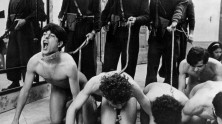
Notes for an African Orestes
(Appunti per un’Orestiade africana)
Italy, 1970, 35mm, color, 63 min.
Italian with English subtitles.
Print source: Cineteca di Bologna
While shooting Medea, a film about the subjugation of the ancient world to an alienating modernity, Pasolini developed the idea to make a companion piece about another Greek myth—the story of Orestes. This story would end more happily, with the archaic making way for a different kind of modernity, built not on exploitation but on communalism. Encouraged by emerging socialist governments in post-colonial Africa, Pasolini hoped to shoot his film there, and so he went to Uganda and Tanzania to scout for locations and actors. That footage became the basis for this film, with Pasolini explaining his ideas on the soundtrack. A perfect example of leftist intellectual auto-critique, the film climaxes with Pasolini discussing his plans with a group of African students in Rome. The discussion hovers somewhere between tragedy and farce as one by one, the students calmly and kindly offer numerous reasonable objections to Pasolini’s idea, all of which he seems to take in stride. The Oresteia project was never made. Little-seen and little-discussed, the film is essential viewing for understanding Pasolini’s political thinking and his attachment to myth.
PRECEDED BY
-
The Walls of Sana’a (Le mura di Sana)
Directed by Pier Paolo Pasolini.
Italy, 1971, 35mm, color, 13 min.
Italian with English subtitles.
Print source: Pasolini Foundation
Pasolini’s rarely screened documentary short explores the incredible architecture of the almost 3,000 year old Yemenese city of Sana’a. With its direct appeal to the spectator to help save these fragile structures, The Walls of Sana’a is offers a moving testimony to Pasolini’s deep attachment to the ancient world.




















